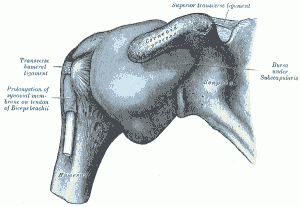Shoulder Instability

Tips Concerning Shoulder Instability
- If you have apprehension to move your arm in a certain direction, seek a medical opinion from a Doctor or Physical Therapist.
- If your shoulder dislocates more than once, it might need to be surgically corrected.
- Surgical correction and thorough rehabilitation program that is performed diligently will enable the patient to return to their pre-surgical status.
- Full recovery from surgical reconstruction and the Physical Therapy rehabilitation program must be followed to its completion and usually lasts 6-12 months.
Restoring Function in the Shoulder Joint
In its simplest form, the shoulder can be thought of as a ball and socket joint. Shoulder instability is a condition when the shoulder joint fails to keep the ball tightly within the socket.
There are several possible conditions that make the shoulder joint loose. It does not always result from a sports injury, impacting athletes and non-athletes alike. If instability exists in the shoulder joint, it may feel like it is about to come out of the socket. In the worst-case scenario, it may come out of socket regularly.
In a healthy shoulder, muscles, ligaments and cartilage provide stability to the joint, but if any of these structures become injured, the joint can become unstable. While the human shoulder is the most mobile joint in the body, its mobility can potentially compromise the stability of the joint.
Shoulder instability can limit one’s function significantly due to pain, loss of motion and muscular weakness. Untreated, the shoulder joint can develop chronic laxity that requires surgery to repair the static stabilizing structures.
Stabilizing Structures for Shoulder
The Glenohumeral joint – This might be likened to a golfball (Humeral Head) on a golf tee (Glenoid Fossa).

The following structures function primarily as the static stabilizing structures of the shoulder joint:
Labrum – This fibrocartilage ring encircles the “lip” of the Glenoid Fossa, making the fossa thicker and helping to make the Humeral Head more secure when it moves within the fossa.
Ligaments – Attached to the edges of the fossa and engulfing the Humeral Head is a fibrous, “leather-like” capsule. The capsule thickens into ligaments in different areas and provides additional stability to the joint by limiting the amount of motion of the Humeral Head.
Damage to any aspect of these stabilizing structures can cause too much motion and unpredictable motion of the Humeral Head. This can result in pain, weakness, decreased strength, decreased function and a strong feeling of insecurity when the arm is moved in certain directions. After a dislocation, there may be damage to the nerves and blood vessels causing numbness, swelling and loss of function. This type of damage might require surgery to correct the injured structures.
Damage in the Glenohumeral Joint
Instability of the GlenoHumeral joint usually occurs secondary to an injury, When the Humeral Head moves with excessive force in an anterior, posterior or inferior direction it can actually tear the Labrum and capsular fibers and dislocate from the Glenoid fossa.
Shoulder instability may also be caused by soft tissue disorders that are genetic in nature (e.g. Ehlers-Danlos Syndrome). These disorders affect all soft tissue and make all ligaments and capsular tissue throughout the body laxer. These disorders are generally associated with MDI of the shoulder joint.
Treating Shoulder Instability
Most dislocations require the Humeral Head to be “reduced” or manually placed back into the joint. The direction of the dislocation (anterior, posterior or inferior) becomes the label for the type of instability that has occurred in the joint. Anterior instability is the most common form of dislocation.
If the Labrum and capsule are damaged in more than one area, or if a person has a pattern of laxity, there can be multi-directional instability (MDI). This type of instability is difficult to rehabilitate and often times does not respond well to surgical intervention.

Physical Therapists are trained to treat shoulder instability.
A Physical Therapy rehabilitation program is usually the initial and long-term treatment for shoulder instability problems. The program is designed to restore the normal motion of the joint, reduce the pain, and regain the strength and function of the shoulder joint. The goal is to help the patient return to their pre-injury life style
The Physical Therapist develops a program concentrating on the restoration of function in the Rotator Cuff and Scapulae stabilizing musculature. These provide dynamic stability to the joint. By conditioning the muscles, the patient’s shoulder is stabilized dynamically, relying less on the damaged Labrum and or capsule.
The Physical Therapist can also educate the patient with a specific rehabilitation exercise routine that will re-establish the “normal” function of the shoulder musculature.

























I’d love to know more about this. I have MDI, Bankhart’s and Hill Sachs in my right shoulder from being in the Army. It’s actually what made me leave 3 years ago. The only recommendation at the time was surgery and I would still opt for it ONLY if i knew there would be complete recovery!